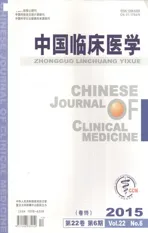七氟醚在临床麻醉中应用的最新进展
2015-01-22赵明晔,苏子敏,葛圣金
·综述·
七氟醚在临床麻醉中应用的最新进展
赵明晔苏子敏葛圣金
(复旦大学附属中山医院麻醉科, 上海200032)
Recent Progress in Application of Sevoflurane for Clinical AnesthesiaZHAOMingyeSUZiminGEShengjin
DepartmentofAnesthesiology,ZhongshanHospital,FudanUniversity,Shanghai200032,China
七氟醚(sevoflurane)又称为七氟异丙甲醚或七氟烷,为无色透明、无刺激性的挥发性液体,由Regan于1968年合成。七氟醚在室温下理化性质稳定,能够迅速、平稳、可预见性地进行麻醉诱导、维持和苏醒,有一定肌肉松驰作用,目前已被广泛应用于临床。此外,七氟醚相关的术后认知功能障碍和器官保护作用近年来得到广泛关注,现就其近几年的研究进展作一综述。
1七氟醚对循环系统的影响
1.1麻醉诱导和维持临床上七氟醚广泛用于婴幼儿麻醉诱导。有研究[1]指出呼气末用4%或5%浓度的七氟醚诱导能较好地预防交感神经系统超活化和维持自主神经系统平衡。七氟醚血/气分配系数较低,仅为0.65(0.62~0.69)。七氟醚麻醉深度可控性强,通过降低循环血管阻力使动脉血压发生剂量依赖性下降,而对心率影响不显著,患者术中血流动力学较为稳定。
1.2七氟醚和QT间期七氟醚通过抑制心肌钾离子通道明显延长按心率校正的QT间期(QTc间期),近19 ms,但对心室跨壁复极离散度无明显影响[2],推测七氟醚不增加室性心律失常发生风险,但用于先天性长QT综合征患者时需谨慎。
1.3七氟醚和心肌保护近年来,七氟醚的研究热点之一是其对心肌的保护作用。体内和体外实验发现,七氟醚预处理[3]和后处理[4]对缺血再灌注损伤心肌都有保护作用,可以改善心肌功能,下调心肌标志物水平,缩小心肌梗死范围。七氟醚后处理可以改善心肌收缩能力,减少心肌再灌注损伤相关心律失常的发生[5],推测七氟醚后处理较预处理在临床上更有优势,但需要严谨的随机对照试验进行验证。七氟醚的心肌保护机制尚不明确,可能包括:缓解再灌注后的线粒体损伤和氧化应激,从而缓解心肌细胞过度地自噬激活[4];调节三磷酸腺苷(ATP)敏感性钾离子通道,从而促进心肌缺血前蛋白激酶C-ε(PKC-ε)磷酸化和下调再灌注时的凋亡相关蛋白含半胱氨酸的天冬氨酸蛋白水解酶-8(cysteinyl aspartate specific proteinase, caspase-8)表达[3];抑制核转录因子κB(NF-κB)并激活内皮型一氧化氮(eNOS)/NO通路,从而抑制肿瘤坏死因子-α(TNF-α)诱导的血管内皮功能损伤[6]等。目前七氟醚对心肌确切的保护机制尚不清楚,需要进一步研究。
有学者曾提出,吸入性麻醉药可以作为缺血再灌注损伤的一种治疗手段,而非仅作为麻醉用药[7]。van der Baan等[8]将七氟醚作为局部抗感染药物进行研究发现,心肌再灌注时局部用药组白介素-6(IL-6)和IL-8的水平较全身用药组下降更明显,但七氟醚对与心肌损伤程度密切相关的心肌肌钙蛋白水平未产生影响;心肌内局部用药和全身吸入用药对心肌作用的差异还需进行大样本随机对照试验。七氟醚能否作为独立于麻醉之外的心肌保护药物还有待大量临床试验证实。
2七氟醚对神经系统的影响
2.1七氟醚和神经保护多种手术,如颈动脉内膜剥脱术和冠状动脉旁路移植术等,存在潜在的脑缺血可能,因此麻醉时应选择有脑保护作用的药物。研究[9]表明,七氟醚能够剂量依赖性地降低脑损伤标志物神经元特异性烯醇化酶(NSE)和S-100蛋白的水平,还能缓解缺血再灌注脑组织的炎性反应、脂质过氧化并能缩小梗死灶面积[10]。不过,目前尚无明确的临床试验证实七氟醚较其他吸入性麻醉药在神经保护方面有优势。
七氟醚对神经的保护作用可能和减少细胞外兴奋性毒性物质如谷氨酸盐有关[11];还有研究[10]认为七氟醚的神经保护作用与其对炎性反应的抑制有关,但七氟醚的这种免疫调节机制尚不清楚;其他可能原因包括抑制神经元凋亡[12]、激活内源性存活通路和促进神经元再生[13]等。
2.2七氟醚和术后认知功能障碍(POCD)POCD是一种常见的术后中枢神经系统并发症,主要表现为记忆、抽象思维和定向能力障碍,同时伴有社会活动能力的减退。麻醉和手术是POCD发生的重要危险因素[14]。POCD的发生与心脏外科手术关系密切,特别是行体外循环心脏手术的患者术后POCD的发生率为50%~80%[9]。而七氟醚因其心肌保护作用广泛用于心脏手术的麻醉维持,故七氟醚和POCD间的关系值得重视。研究[15]发现,心脏手术中,七氟醚组较丙泊酚组有更好的短期(<7 d)术后认知结局。但Xu等[16]认为,除了年龄、主动脉阻断时间外,七氟醚也是POCD发生的独立危险因素之一。其发现低浓度七氟醚麻醉伴随有较高的术后POCD发生风险;反之,较高浓度七氟醚麻醉可能产生潜在的保护作用,但相关结论需要进一步的随机对照试验来验证。非心脏手术中,Shoair等[17]认为,七氟醚麻醉、APOE4基因型、术前应用1种或多种抗胆碱能或镇静催眠药物均与术后POCD的发生相关。
2.2.1神经炎性反应和凋亡神经炎性反应在认知损伤发生中起重要作用。七氟醚吸入后,海马区促炎细胞因子(IL-6、TNF-α等)水平增高,进而激活小胶质细胞,小胶质细胞进一步释放促炎细胞因子,发生级联反应,导致中枢神经系统发生炎性反应,最终引起认知功能改变[18]。有报道指出,七氟醚可导致神经元变性凋亡[19],也可以使大鼠海马区内质网应激标志物C/EBP同源蛋白(C/EBP homologous protein, CHOP)和caspase-12表达上调[20],提示七氟醚诱导的神经元变性凋亡和内质网应激有关。不过,七氟醚诱发内质网应激的机制尚不明确,可能与七氟醚导致的神经元内钙离子水平紊乱和氧化应激有关。
2.2.2神经突触和递质中枢胆碱能系统在学习、记忆等认知功能的调节中起重要作用。Peng等[21]发现,七氟醚可以抑制毒蕈碱样乙酰胆碱受体1(M1受体) mRNA表达,且M1受体表达减少程度与大鼠认知损伤程度一致。此外,七氟醚相关认知损伤可能与其抑制海马突触的长时程增强(long-term potentiation, LTP)从而能影响突触的可塑性相关[22]。
2.2.3血脑屏障Hu等[23]发现,呼气末持续2 h吸入1.5最低肺泡有效浓度(MAC)七氟醚可使海马区基质金属蛋白酶-2(MMP-2)和MMP-9表达增加,下调紧密连接蛋白occludin,加重大鼠术后认知损伤和海马血脑屏障(blood brain barrier, BBB)的破坏,提示吸入性麻醉气体引起的认知障碍可能与BBB通透性破坏有关。但也有研究[24]指出,七氟醚预处理通过抑制细胞黏附分子和MMPs表达起到BBB保护作用;在Hu等[23]的实验中,尽管occludin发生下调,但另一个BBB重要组成蛋白claudin-5表达未改变[23],所以BBB破坏假说还有待进一步验证。
2.2.4阿尔茨海默病(Alzheimer disease, AD)Van der Jeugd等[25]研究指出,tau蛋白过度磷酸化和总tau蛋白浓度增高与记忆认知功能损伤有关。Le Freche等[26]发现,七氟醚可通过激活丝裂原活化蛋白激酶(mitogen-activated protein kinase, MAPK)和丝氨酸-苏氨酸蛋白激酶/糖原合成酶激酶3(AKT/GSK3)信号转导通路使tau蛋白磷酸化水平增高,且反复长期(每个月1 h,持续5个月)维持后,tau蛋白呈现持续性过度磷酸化,而过度磷酸化的tau蛋白是AD神经元内双螺旋微丝的主要组成成分,提示吸入麻醉药所致的术后认知改变与AD发病通路可能具有共性,这可能为临床预防和治疗POCD提供新的方向。
3七氟醚对其他脏器的影响
七氟醚无色透明、无刺激性,易被患儿接受,很少导致喉痉挛,且对气道平滑肌有松弛作用。有研究[27]指出,七氟醚可以明显减轻循环中性粒细胞脱颗粒反应,降低TNF-α、IL-β等炎性因子水平。Sun等[28]指出,七氟醚主要通过对Toll样受体4(Toll like receptor 4, TLR4)/NF-κB通路的抑制缓解急性炎性肺损伤。肺功能障碍是肺缺血再灌注损伤的主要并发症和致死原因。有研究[29]显示,七氟醚预处理可上调紧密连接蛋白occludin和闭合小环蛋白1(ZO-1)表达,从而改善肺泡-毛细血管膜通透性,这可能与七氟醚抑制蛋白激酶C-α(PKC-α)转位激活有关。但七氟醚是如何通过PKC-α调节紧密连接蛋白表达的,尚需进一步研究,且紧密连接和PKC-α转位激活之间的因果关系仍有待验证。
七氟醚在体内的代谢率约为3%,虽然长时间使用七氟醚镇静的重症监护患者的无机氟化物水平明显高于丙泊酚镇静患者,但七氟醚对肝肾功能不产生明显不利影响[30]。七氟醚对发生缺血再灌注的肝脏有保护作用,可能与七氟醚下调miR-1、miR-133和miR-205水平,增强AKT/GSK-3β通路活化状态,从而促进肝细胞增殖因子细胞周期蛋白D1(cyclin D1)表达有关[31]。
Liu等[32]研究了七氟醚对肠缺血再灌注损伤(intestinal ischemia-reperfusion injury, IRI)的影响,结果显示,呼气末用0.5%浓度的七氟醚预处理的保护作用最优,该保护作用可能与七氟醚上调抗凋亡基因bcl-2表达和抑制caspase-3活化有关,也有可能是与七氟醚预处理缓解了IRI相关的低血压从而改善了肠血流及其氧合作用有关。
4小结
七氟醚理化性质稳定,血/气分配系数低,麻醉深度可控性强,能实现快速诱导和苏醒,用其进行麻醉维持对呼吸、循环影响小,且具有潜在器官保护作用,临床中已广泛应用。目前关于七氟醚对器官的保护作用仍有争议,应把握七氟醚预/后处理时机,争取最大限度利用这一优势以改善患者预后。同时,七氟醚相关的QT间期延长、术后认知损伤等不良事件值得重视,明确其发生机制选择恰当的干预措施,这是今后临床和基础研究的主要任务。
参考文献
[ 1 ]Hanamoto H, Boku A, Morimoto Y, et al. Appropriate sevoflurane concentration to stabilize autonomic activity during intubation with rocuronium in infants: a randomized controlled trial[J]. BMC Anesthesiology, 2015,15(1):1-7.
[ 2 ]Lee JH, Park YH, Kim JT, et al. The effect of sevoflurane and ondansetron on QT interval and transmural dispersion of repolarization in children[J].Paediatr Anaesth, 2014 ,24(4):421-425.
[ 3 ]Wang C, Hu SM, Xie H, et al. Role of mitochondrial ATP-sensitive potassium channel-mediated PKC-ε in delayed protection against myocardial ischemia/reperfusion injury in isolated hearts of sevoflurane-preconditioned rats[J]. Braz J Med Biol Res,2015,48(6):528-536.
[ 4 ]Yu P, Zhang J, Yu S, et al. Protective effect of sevoflurane postconditioning against cardiac ischemia/reperfusion injury via ameliorating mitochondrial impairment, oxidative stress and rescuing autophagic clearance[J].PLoS One,2015,10(8):e0134666.
[ 5 ]Gong JS, Yao YT, Fang NX, et al. Sevoflurane postconditioning attenuates reperfusion-induced ventricular arrhythmias in isolated rat hearts exposed to ischemia/reperfusion injury[J].Mol Biol Rep,2012,39(6):6417-6425.
[ 6 ]Li S, Xu J, Yao W, et al. Sevoflurane pretreatment attenuates TNF-α-induced human endothelial cell dysfunction through activating eNOS/NO pathway[J].Biochem Biophys Res Commun,2015,460(3):879-886.
[ 7 ]Anderson S L, Duke-Novakovski T, Singh B. The immune response to anesthesia: Part 1[J]. Veterinary Anaesthesia and Analgesia, 2014,41(2):113-126.
[ 8 ]van der Baan A, Kortekaas KA, van Es E, et al. Sevoflurane-enriched blood cardioplegia: the intramyocardial delivery of a volatile anesthetic[J].Perfusion, 2015, 30(4):295-301.
[ 9 ]Xu JH, Zhang TZ, Peng XF, et al. Effects of sevoflurane before cardiopulmonary bypass on cerebral oxygen balance and early postoperative cognitive dysfunction[J].Neurol Sci,2013,34(12):2123-2129.
[10]Bedirli N, Bagriacik EU, Emmez H, et al. Sevoflurane and isoflurane preconditioning provides neuroprotection by inhibition of apoptosis-related mRNA expression in a rat model of focal cerebral ischemia[J].J Neurosurg Anesthesiol, 2012,24(4):336-344.
[11]Peng S, Kalikiri P, Mychaskiw G 2nd, et al. Sevoflurane postconditioning ameliorates oxygen-glucose deprivation-reperfusion injury in the rat hippocampus[J]. CNS Neurosci Ther,2011,17(6):605-611.
[12]Jeon YT, Hwang JW, Lim YJ, et al. A combination of sevoflurane postconditioning and albumin increases Bcl-2 expression after transient global cerebral ischemia compared with either sevoflurane postconditioning or albumin alone[J].J Neurosurg Anesthesiol,2013,25(1):43-50.
[13]Nie H, Peng Z, Lao N, et al. Effects of sevoflurane on self-renewal capacity and differentiation of cultured neural stem cells[J].Neurochem Res,2013,38(8):1758-1767.
[14]陈玢,郑晖. 吸入麻醉药与术后认知功能障碍关系的研究进展[J]. 医学综述,2013,10:1850-1852.
[15]Schoen J, Husemann L, Tiemeyer C, et al. Cognitive function after sevoflurane- vs propofol-based anaesthesia for on-pump cardiac surgery: a randomized controlled trial[J].Br J Anaesth,2011,106(6):840-850.
[16]Xu T, Bo L, Wang J, et al. Risk factors for early postoperative cognitive dysfunction after non-coronary bypass surgery in Chinese population[J].J Cardiothorac Surg,2013,8:204.
[17]Shoair OA, Grasso Ii MP, Lahaye LA, et al.Incidence and risk factors for postoperative cognitive dysfunction in older adults undergoing major noncardiac surgery: A prospective study[J].J Anaesthesiol Clin Pharmacol, 2015,31(1):30-36.
[18]Shen X, Dong Y, Xu Z, et al. Selective anesthesia-induced neuroinflammation in developing mouse brain and cognitive impairment[J].Anesthesiology, 2013, 118(3):502-515.
[19]Bittner EA, Yue Y, Xie Z.Brief review: anesthetic neurotoxicity in the elderly, cognitive dysfunction and Alzheimer′s disease[J].Can J Anaesth,2011, 58(2):216-223.
[20]Chen G, Gong M, Yan M, et al. Sevoflurane induces endoplasmic reticulum stress mediated apoptosis in hippocampal neurons of aging rats[J].PLoS One,2013,8(2):e57870.
[21]Peng S, Zhang Y, Li GJ, et al. The effect of sevoflurane on the expression of M1 acetylcholine receptor in the hippocampus and cognitive function of aged rats[J].Mol Cell Biochem,2012,361(1-2):229-233.
[22]Haseneder R, Kratzer S, von Meyer L, et al. Isoflurane and sevoflurane dose-dependently impair hippocampal long-term potentiation[J].Eur J Pharmacol, 2009,623(1-3):47-51.
[23]Hu N, Guo D, Wang H, et al. Involvement of the blood-brain barrier opening in cognitive decline in aged rats following orthopedic surgery and high concentration of sevoflurane inhalation[J].Brain Res,2014,1551(11):13-24.
[24]Yu Q, Chu M, Wang H, et al. Sevoflurane preconditioning protects blood-brain-barrier against brain ischemia[J].Front Biosci (Elite Ed),2011,3(3):978-988.
[25]Van der Jeugd A, Ahmed T, Burnouf S, et al. Hippocampal tauopathy in tau transgenic mice coincides with impaired hippocampus-dependent learning and memory, and attenuated late-phase long-term depression of synaptic transmission[J].Neurobiol Learn Mem,2011,95(3):296-304.
[26]Le Freche H, Brouillette J, Fernandez-Gomez FJ, et al. Tau phosphorylation and sevoflurane anesthesia: an association to postoperative cognitive impairment[J].Anesthesiology,2012,116(4):779-787.
[27]Minguet G, de la Rebiere G, Franck T, et al. Sevoflurane inhibits equine myeloperoxidase release and activity in vitro[J]. Vet Anaesth Analg, 2013,40(2):166-175.
[28]Sun XJ, Li XQ, Wang XL, et al. Sevoflurane inhibits nuclear factor-κB activation in lipopolysaccharide-induced acute inflammatory lung injury via toll-like receptor 4 signaling[J].PLoS One,2015,10(4):e0122752.
[29]Chai J, Long B, Liu X, et al.Effects of sevoflurane on tight junction protein expression and PKC-α translocation after pulmonary ischemia-reperfusion injury[J].Exp Mol Med,2015,47:e167.
[30]Gallego L, Soro M, Alvarino A, et al. Renal and hepatic integrity in long-term sevoflurane sedation using the anesthetic conserving device: a comparison with intravenous propofol sedation in an animal model[J].Rev Esp Anestesiol Reanim,2015,62(4):191-203.
[31]Morita T, Ishikawa M, Sakamoto A. Identical microRNAs regulate liver protection during anaesthetic and ischemic preconditioning in rats: an animal study[J].PLoS One,2015,10(5):e0125866.
[32]Liu C, Shen Z, Liu Y, et al. Sevoflurane protects against intestinal ischemia-reperfusion injury partly by phosphatidylinositol 3 kinases/Akt pathway in rats[J].Surgery,2015,157(5):924-933.
中图分类号R971.2
文献标识码A
通信作者葛圣金E-mail:geshengjin@fudan.edu.cn
